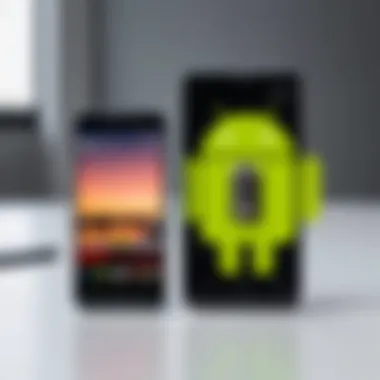Exploring Unique Android Phones: Features and Innovations


Intro
The world of Android phones presents an overwhelming selection for consumers, with new models surfacing regularly. Amidst this abundance, a great number of these phones offer remarkable features that challenge conventional norms.
As the market evolves, individuals look for unique devices that bring something extra to the table. This guide aims to be a beacon for those tech-savvy Android users, illuminating options that can surpass typical choices and cater to specific tastes and preferences.
In this guide, readers will find an exploration of noteworthy characteristics, comparisons, and practical recommendations. The intent is to foster an enlightened purchasing experience.
Product Overview
In this section, we will delve into the defining attributes of unique Android phones. A seductive display, reliability, performance, and price point are just a few specifications discussed in the subsections.
Specifications
Unique Android phones generally boast unique specifications that differentiate them from standard options. These may include elaborate camera systems, cutting-edge chipsets for computing power, and impressive RAM capacities. Brands like Asus and OnePlus, continue to push tech boundaries, frequently integrating designs and capabilities rarely seen in mainstream offerings.
Some examples of noteworthy specifications are:
- Processor: Look for phones equipped with Snapdragon 8 Gen 2 for exceptional performance.
- Camera: Certain devices, like the Google Pixel series, may have advanced photography features.
- Display: OLED screens and high refresh rates contribute to outstanding visuals.
Design
Design matters in functionality and aesthetics alike. Unique models often bring an innovative approach to design. While some embrace minimalism, others opt for bold and elaborate forms. Devices from brands such as Samsung with their Galaxy Z series, redefine typical foldable technology while remaining visually striking.
Important design features can include:
- Materials: Premium glass and metal combinations may convey luxury.
- Weight: Consider lightweight designs focusing on portability.
- Color options: The variety suggests personal expression.
Features
A compelling array of features separates these Android phones apart. Features may include:
- Advanced Biometrics: In-screen fingerprint sensors enhance security and convenience.
- 5G Connectivity: Future-proof your device with 5G speeds for seamless browsing.
- Unique UI Skins: Phone interfaces like Samsung's One UI focus on enhancing user experience.
Pricing
Pricing can cover a wide spectrum, primarily influenced by cutting-edge features and brand positioning. With certain devices priced under $300 and others exceeding $1,000, awareness of what justifies the expense is critical. Unique models often target a higher price point, aiming to recoup investments made in innovation.
Performance and User Experience
User experience intertwines closely with performance. In this section, we evaluate speed, battery life, and user interface tailoring.
Speed
Performance performs exceptionally well across many unique Android phones. Devices such as the Asus ROG Phone 6 attract gamers and power users with high performance. Geared with top-tier CPUs and GPUs guarantees smooth multitasking and gameplay.
Battery Life
Battery efficiency directly impacts usability. Uniquely feature-rich phones, like the Motorola Moto G Power, substantiate longer usage times while accommodating diverse user needs.
User Interface
A customized user interface reflects personal preference - both design and functionality-wise. Several brands tailor their Android skin. One can appreciate the material and its capability features.
Customization Options
The ability to modify settings offers an appealing canvas for creativity. Android, by nature, allows alterations like icon packs and even full theme changes, satisfying personalized designs driven by users.
Comparison with Similar Products
Delving deeply into comparisons can be profound. Examining distinctions give one insights beyond labels.
Key Differences
This segment emphasizes those minuscule nuances pulling apart models fighting for the same market.
- Camera quality alone can dictate user preference. Brands may focus on AI enhancements miniatures.
- Price/Performance Ratio Consider how far one's budget stretches in relation to features.
Value for Money


Brands pushed innovation close or beyond markets suggests effective value. Sometimes larger name markets overshadow small-tier companies which offer compelling capabilities, leading customers needing insights into unknown territories.
Expert Recommendations
Herein lies the conclusion based on community insights and experiences compiled.
Best Use Cases
Clearly defining functions point a precise guide:
- Photographers might enjoy the prowess of devices like the Samsung Galaxy S series.
- Gamers may prefer performance-centric Ars ZenBook Pro.
Target Audience
A diverse customer base will resonate best according to usage preferences. Tech enthusiasts might appreciate varieties in customization and complexity while other user categories prioritize battery reliability, basic performance, or screen capabilities.
Final Verdict
Ultimately, choosing provocative Android phones does demand slightly narrowed respect. Next-generation qualtities become significant components in selections, ensuring informed decisions become the mainstay for tech-forward souls; this motivates continual brand innovation.
Closure
Conclusively, seeking unique Android phones requires engaging with vast details. Building sound knowledge, having a clear head evolves choices benefiting all who investigate.
The Concept of Unique Android Phones
Unique Android phones represent a fascinating niche in the broad mobile market. As technology evolves, users are increasingly looking for devices that not only fulfill basic functions but also offer distinctive features and capabilities that stand out. The exploration of unique Android phones is essential as it focuses on the spinaltype from mainstream options, providing enhanced user experience with designs and technologies usually overlooked by bigger brands.
Defining Uniqueness in Android Devices
When one discusses the uniqueness of Android devices, it is crucial to pinpoint what such uniqueness entails. Unique does not only mean rare; it implies specifications, design philosophies, and usage scenarios that set a device far apart from its peers.
Here are a few aspects to reflect upon:
- Design Choices: A striking aesthetic can significantly influence user perception.
- Functionality: Devices that offer features appealing to specialized user bases.
- Performance: Higher-end specifications that cater to heavy users like gamers or business professionals.
This definition of uniqueness encourages prospective buyers to shift their perspective. Instead of seeing all Android devices through a general lens, they can appreciate the specific strengths and innovations of lesser-known brands, which may fulfil their requirements more aptly.
The Importance of Distinctive Features
A phone's unique traits can often transform the user's interaction with technology. These distinctive features catalyze not just user satisfaction but also create trust in the brand. For instance, let’s examine some notable distinctive features that contribute to the device's allure:
- Camera Innovations: Manufacturers like Pixel have typically aimed at superior photography performance while others play with lens choices.
- Modular Designs: Companies such as Fairphone advocate for repairs and sustainability; allowing users.
- Customization Options: Offering a customizable Android experience enhances user engagement and satisfaction.
Emphasizing distinctive features broadens the horizons for consumers looking for personalized experiences, inviting them to delve deep into the potential that unique models present. Evaluating these aspects will ultimately facilitate informed purchasing decisions, rather than impulsively settling on more popular or advertised brands.
Unique Android phones offer not just utility, but also richer experiences tailored to individual preferences.
Market Overview of Android Phones
The landscape of Android phones is vast and intricate, shaped by a mix of established players and innovative newcomers. Understanding this market overview enables consumers to contextualize their choices. As Android continues to dominate the smartphone industry, the growth of features and innovations directly correlate to changing user behaviors. Distinguishing between various offerings will empower users to make more informed decisions about their mobile devices.
Key Players in the Android Market
When discussing key players in the Android ecosystem, several brands come to mind. These companies not only set standards but also shape crucial parts of mobile technology development. Key contenders include:
- Samsung: Renowned for its Galaxy series, Samsung pushes the envelope with features that often define benchmarks—for example, display refresh rates and camera technology.
- Google: With the Pixel line, Google emphasizes integration with its ecosystem, showcasing advanced computational photography and the Android experience in a clean form.
- OnePlus: Known for its flagship-killer models, OnePlus combines high-end specs with aggressive pricing, garnering a loyal user base that appreciates value.
- Xiaomi: This brand excels in providing features at competitive prices, making smartphones accessible to diverse consumer bases worldwide.
Among these key players, distinct approaches elevate the competition, making Android devices far more versatile.
Emerging Brands and Innovations
The smartphone market is not solely defined by established giants. Various emerging brands also increasingly capture consumer attention through different technological innovations. Innovations change user interactions, refresh market choices, and offer experiences that were not possible in previous formats. Highlights include:
- Realme: A sub-brand of Oppo, Realme targets younger buyers while delivering ample features. Its strong emphasis on design exemplifies current trends in the smartphone market.
- Nothing: Breaking the norms with a transparent aesthetic, Nothing brings unique ethical branding and will soon aim to change user engagement with their minimalist philosophy.
- Asus: Primarily known for gaming hardware, their ROG Phone series brings powerful gaming experiences to Android devices, specifically catering to gamers seeking a premium experience.
Emerging brands promise to further diversify the Android space, providing unique visions that resonate with modern users.
By tracking these advancements and recording innovation trends, future purchasing decisions become more informed. Awareness in market overview helps consumers prioritize which distinctive features align with both legacy brands and new avenues. Selection today involves much more thoughtful analysis than simply looking at price versus specs alone.
Standout Features of Unique Android Phones


Unique Android phones offer a broad range of standout features that can significantly enhance the user experience. In a market saturated with devices presenting similar specifications and capabilities, it is the distinctive elements that separate exceptional phones from average ones. These features often address the specific needs of users, whether in terms of performance, design, or usability. Exploring such traits not only deepens the understanding of technological innovation within Android devices but also aids consumers in making informed choices while navigating this complex landscape of options.
Design Elements That Set Devices Apart
The design of a phone is often the first aspect that noticeably captures consumer interest. Unique Android phones emphasize innovative design elements to attract users. From sleek, edge-to-edge displays to niche materials such as ceramic or bamboo, the aesthetic appeal of a device plays a crucial role.
Material choice enhances both wrinkles in look and plays practical roles; consider, for instance, the presence of varying finishes that provide grip or reduce fingerprints. Some manufacturers experiment with unusual form factors, like foldable or rollable designs. Such innovation fundamentally changes the user interaction by allowing mew functionalities, like compact storage without missing full-screen real estate when in use.
Important factors although include weight and size. Brands like Samsung and Xiaomi have put significant effort into achieving lighter and more comfortable designs, balancing style with functionality. These design elements not only distinctively position devices but also lead to greater consumer satisfaction through enhanced utility.
Advanced Camera Technologies
In the realm of unique Android phones, advanced camera technologies have increasingly become a focal point. High-resolution sensors, multiple camera setups, and sophisticated software algorithms are now standard in premier smartphones. Camera innovations such as super-speed autofocus and optical image stabilization allow users to capture professional-like photos with hd clarity.
Moreover, specialized features like 108MP sensors in devices such as the Xiaomi Mi 11 can help in the detailed capturing of images even in lower-light conditions. Combine this with AI enhancements that intelligently adjust settings automatically – the result is a simplified user experience tailored to produce high-quality results. Furthermore, popular brands actively explore trends like macro photography and cinematic video recording that caters to a more diverse target audience interested in visual creativity.
However, consumers must delve into the details regarding color accuracy and low-light performance to find devices that truly align with their photographic ambitions. An informed choice can lead to rewarding results, transforming ordinary moments into extraordinary pieces of personal storytelling.
Innovations in Battery Life and Charging
Battery technology greatly influences user experience in unique Android phones. As applications become more demanding, efficient consumption of battery power becomes essential. Leading brands have responded with innovations aimed at enhancing endurance and recharging speed.
Features such as fast charging and wireless charging now accompany many Android devices. The likes of OnePlus and Oppo have developed proprietary systems capable of delivering a full battery in under an hour, drastically reducing downtime and improving convenience.
Furthermore, developments in battery materials and configuration design support longer lifetimes and greater mobility. For example, phones using lithium polymer batterries provide slightly more capacity in smaller sizes. Learning about adaptive battery management helps users extend battery life, satisfying the need for continuously rich, competent performance. Overall, being knowledgeable about battery features promote a fulfilling usage experience while avoiding frustration from unexpected power failures.
“When selecting unique Android devices, paying attention to standout features can make an incredible difference in daily experiences.”
User Experience and Unique Android Phones
Understanding user experience is vital for those navigating the diverse landscape of Android phones. A unique Android phone does more than just relay information; it shapes the fundemental way users interacts with technology. With distinct features and customizations, these devices can cater to individual preferences, ensuring user satisfaction and engagement. Thus, the way one experiences a phone influences everything from productivity to entertainment.
Software Customizations
Software customizations are a key aspect of enhancing the user experience on unique Android phones. Manufacturers often allow users to tailor the operating systems. This capability lets users adjust the interface, add preferred applications, and enable specific functional features. Brands like OnePlus and Samsung offer their iterations of Android, giving users a taste of personalization.
- Customization Options:
- Themes
- Launcher modifications
- Widget placements
These options not only make the device stand out visually but also contribute to usability. A personalized interface can boost daily efficiency. Individuals can place frequently used apps right on their home screens or adjust settings to streamline their workflow. Furthermore, many users appreciate the sense of control that comes with personalizing their devices, as it can reflect their style and needs.
User Interface Innovations
When discussing unique Android phones, user interface innovations cannot be overlooked. They significantly impact how users interact with their devices. Emerging trends focus on providing seamless navigation through intuitive designs.
Recent advancements in gesture controls and voice activation technologies offer users alternative interaction options. Rather than relying solely on physical buttons, these innovations make accessing features more accessible. Accessibility becomes a primary consideration for those who may struggle with standard navigation.
An enhancement in spatial awareness involved in UI designs also impacts the user's flow. Instead of clutter, having organized layouts prevents overwhelming the user, promoting an inviting environment for interaction. Some distinct unique Android phones utilize minimalistic modes, ensuring a clean aesthetic that encourages usability.
In summary, user experience revolves around how well a device accommodates individual styles and preferences. Software customizations allow personalization while interface innovations facilitate interaction. The evolving technology promises an enriched user journey for those exploring unique Android phones.
Comparative Analysis of Unique Android Models
Comparative analysis of unique Android models is essential because it clarifies how various devices stack up against each other. The intricacies of different features matter for users trying to choose a phone that suits their needs. With numerous options available, understanding the specifications, performance, and unique traits becomes crucial. One significant benefit of this analysis is that it allows users to make knowledgeable choices. Unique Android phones offer solutions tailored to user preferences, and a structured comparison highlights these distinct advantages. Additionally, as technology advances rapidly, staying abreast of market offerings enhances the decision-making process.
High-End Unique Options
High-end unique Android phones cater to consumers who prioritize premium features and cutting-edge technology. These devices typically include advanced display technologies, such as stunning AMOLED screens that enhance immersive viewing experiences. For instance, models like the Samsung Galaxy S23 Ultra offer not only rich colors but also superior brightness levels, making them suitable for both outdoor use and media consumption.
Performance is another crucial factor in this category. High-end models often house the latest processors, such as Qualcomm Snapdragon 8 Gen 2 or Exynos 2200, allowing for rapid application launches and high-quality gaming performance without lag. Furthermore, these devices usually feature enhanced camera systems, capable of capturing detailed images in various lighting conditions. It's not uncommon to find functionalities like 100x digital zoom or multi-camera setups that cater to photography enthusiasts.
A feature that commonly stands out in this category is the build quality. Premium models are often crafted from materials like aluminum and Gorilla Glass, ensuring durability while also providing a sleek, modern look. In contrast to other segments, high-end unique options will typically embrace recently introduced technologies, like under-display fingerprint sensors or advanced cooling systems for prolonged usage, reinforcing their appeal for users who seek exclusivity.
Mid-Range Alternatives
Mid-range unique Android smartphones present an attractive balance between performance and price. These devices incorporate many characteristics of high-tier phones but do so at a accessible price point. Models such as Google Pixel 7a showcase the power of efficient processing practicality, offering decent performance thanks to their solid chipsets like Google's Tensor G2.
Camera capabilities in this tier are noteworthy as well. While these smartphones might not offer the extreme capabilities seen in their high-end counterparts, they still often deliver good quality photographs with advanced computational photography features. Therefore, even at a mid-range price, consumers can enjoy unique images that rival more expensive models during casual usage.
Design also deserves attention. Mid-range options tend to incorporate stylish features without an extravagant price. Users typically find intriguing designs, vibrant colors, and a range of textures that allow customization appealing to buyers. Battery life remains a focus in this level; reasonable capacities satisfy daily usage criteria while benefiting from innovations like quick charging technologies.


Budget-Friendly Unique Choices
Budget-friendly unique Android phones appeal to cost-conscious consumers who refuse to sacrifice quality for price. These devices introduce unique features at lower price points. The Moto G Power (2023) is an example of offering impressive battery longevity and connectivity features without high financial investment.
Beyond affordability, these smartphones typically bring features that help them stand out. For example, while they may not have the latest processor, many budget options leverage competent chips to deliver satisfactory performance for everyday tasks like browsing, social media, and messaging. Interestingly, they also provide impressive software support, ensuring updates and security patches, elements that are often undervalued in this segment.
Design is streamlined, embodying simplicity while maintaining practical aspects. Choices in this category often still feature durable materials and impressively bright displays. Further, manufacturers often include technology innovative for the price range, such as NFC for contactless payments or dual-SIM options.
Through these analyses, potential Android users can gauge where each model fits their requirement frameworks, aiding them in understanding market offerings more profoundly.
The Role of Consumer Feedback
Consumer feedback plays a pivotal role in shaping the trajectory of unique Android phones. In an era where technology evolves rapidly, understanding how users perceive a product is crucial for manufacturers. Insightful reviews and ratings indicate what features are most valued, flaws consumers encounter, and how overall satisfaction can be achieved. By tapping into this feedback, companies can make informed design decisions, thus enhancing their product offerings.
Moreover, consumer opinion allows potential buyers to gauge the real-world performance of devices. A customer’s experience often elucidates aspects that maybe marketing materials overlook. Beyond aesthetics, key components – such as durability or battery lifecycle – come to life through user narratives. Product lifespan and usability assessments become clearer with holistic insights from actual users. Therefore, feedback not just assists brands; it directly influences prospective buyers in their quest for the best.
Customer Reviews and Ratings
Customer reviews act as modern word-of-mouth advertising. They present a dual benefit for both consumers and manufacturers.
For consumers:
- Initial Decision-Making: Reviews often serve as a initial source for assessing specs and features. They can validate what looked compelling during sleek advertisements.
- User Experiences: Ratings provide insight on common issues or delights that arise with smartphone use, covering areas like repurcussions from software updates or unique functionalities that may be hindered in practice.
- Value for Money: Through reviews, consumers can ascertain whether the money aligns with performance. A transition from a mere wish-list item to an informed purchase decision becomes lättare through conscientious consumer insights.
For manufacturers:
- Design Problem Areas: An accumulation of complaints can signal larger issues. Regular benchmarking against user feedback can direct enhancements or on-field changes on newer releases.
- Feature land Rom Showcase: Effective customer feedback can bring forth lesser-known features deserving attention. Unique functions perceived valuable by users often play a marketing role in shaping the manufacturers' promotions around a new product launch.
Case Studies of Unique Phones
Analyzing specific models further highlights the importance of consumer feedback. For instance, the Essential Phone was praised for its minimalist design and premium build influence but sufferred from criticism regarding its limited camera functionality. Detailed case studies like these allow tech enthusiasts to appreciate both the advancements and challenges faced by companies while navigating customer expectations.
Following brands like OnePlus illustrates how continuous feedback has steered product refinement. Initially gaining traction on excellent performance-to-price ratio, user feedback positioned them into focusing overtly on establishing brand loyalty through iterative product naming and timed releases of software updates franz recipient forums for customization and tweaks.
Crucially, implementing user suggestions doesn't just result in successful growth but fosters a sense of community. Ensuring the technology aligns with consumers indefinitely benefits satisfaction.
So it becomes evident that active engagement with consumer feedback sets the backbone of innovation in the Android domain, and defines what makes each смартфон unique.
Future Trends in Android Phone Design
The landscape of Android phones is in a constant state of flux. As technology advances, the designs also evolve. Understanding future trends in Android phone design is crucial for both manufacturers and consumers. These trends define how Android devices will meet user demands, adapting to exciteng lifestyles and the fast-paced digital world.
Potential Technological Advancements
Advancements in technology pave the way for new features and designs. Possible future innovations include:
- Foldable Displays: The concept of foldable smartphones is already taking shape. Future models may feature more flexible screens with improved durability. This allows for larger displays in more compact devices.
- Modular Components: Imagine a phone where you can swap out individual parts. Modular designs could become standard. This enables users to upgrade specific features, like cameras or batteries, without disposing of the entire device.
- Sustainable Materials: As environmental concerns rise, sustainable materials may feature prominently in phone design. Manufacturers might focus on recyclable or biodegradable materials to cater to eco-conscious users.
- Wireless Charging Innovations: Enhanced wireless charging systems could emerge, reducing charging time significantly. This might lead to more creative designs, eliminating the need for charging ports.
These aforementioned advancements offer significant advantages. They enhance usability and streamline the user experience, allowing for greater versatility and personalization.
The Impact of AI and Machine Learning
AI and machine learning are revolutionizing more than just software. They are beginning to influence hardware design and user experiences in profound ways. Consider their impact on future Android phones:
- Smart Assistance: Advanced AI can make devices more intuitive. Understanding user habits can optimize performance and recommendations.
- Photography Enhancements: With machine learning, smartphones can automatically analyze scenes, adjust settings, and enhance photo quality. This democratizes photography, making it accessible to all.
- Resource Management: AI algorithms can optimize battery consumption. Phones may learn which apps need more power at certain times, lengthening battery life significantly.
“The intersection of hardware and artificial intelligence will define the sophistication of future Android devices.”
End: Making Informed Choices
Making informed choices when selecting an Android phone is essential for enhancing the overall mobile experience. With a market crowded by numerous options, emphasizing the key elements can save both time and money. This article has shown how unique Android devices can transform personal and professional life, showcasing various features that define their appeal.
Evaluating Your Needs
Before diving into the array of smartphones available, it is imperative to assess individual needs. Identify the critical aspects you require in a phone. Ask yourself questions such as:
- What is my primary use? Social media, gaming, or productivity may dictate different preferences.
- What specifications suit my needs? Display size, camera capabilities, and battery life are significant considerations.
- What's my budget? Determine a price range beforehand to narrow the options efficiently.
Creating a checklist based on these queries helps align features with your requirements. For instance, if you prioritize photography, look for models with advanced camera systems like the Google Pixel or Samsung Galaxy series. Understanding personal needs fosters more meaningful selections, enhancing long-term satisfaction.
The Importance of Keeping Up with Trends
The tech landscape evolvs rapidly. Staying current with trends enables consumers to make choices reflecting modern advancements. Unique Android phones are a nexus of smartphone evolution, often acting as early adopters for features that become standard over time. Key trends to follow include:
- AI Integration: Many new devices offer AI enhancements, improving user responsiveness and personalization.
- Battery Technology Advances: From fast charging to ultra-efficient battery life, brands introduce novel solutions constantly.
- Sustainable Models: With an increasing focus on the environment, brands are producing more eco-friendly options.
Engaging with these trends provides insight into what devices may soon redefine user experience. Awareness of innovations can not only guide purchases but also indicate broader shifts in mobile technology.







